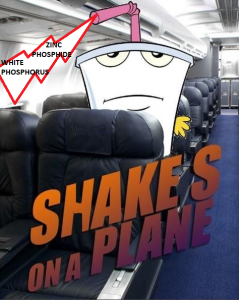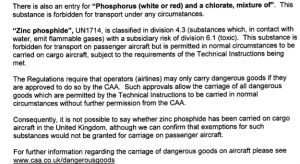The following request for information took us on a “journey” to 4 different authorities before finally arriving at our information destination.
BACKGROUND
The following article appeared in a 1965 edition of Albright World and details the export of the rat poison Zinc phosphide under the title
“A+W combat Russian rat plague.”
“In recent months reports have reached us that a plague of rats is sweeping throughout East European countries. But what may be a threat to the Soviet economy has meant a dramatic upsurge in Albright and Wilson (mfg) production of zinc phosphide. A+W (Mfg) have been making this chemical for years. Its only major use is as a rat killer and the demand for it, although steady, has never been particularly big.
That was until the middle of last year when out of the blue came a big contract from Russia. Then in February of this year came two ‘rush’ orders from Hungary. On February 16 Chemolimpex, one of Hungary’s state trading organisations, urgently cabled A+W for zinc phosphide. They must have wanted in badly because they instructed that the first 13 tons should connect with a special plane being flown from Budapest to London airport on February 19; the rest was to follow by sea. Apart from speeding delivery the main reason that the Hungarians sent their own plane was because no other airline would have been prepared to take the risk of carrying zinc phosphide. If it gets damp it releases phosphine gas- a deadly poison gas.
The lads at Oldbury set-to with a vengeance and delivered on time, but no sooner had they regained their breath when a repeat order arrived on February 26. More was required, and again a special plane from Hungary’s Malev Airline was flown over from Budapest. Indeed, it all sounds very good for our export figures, but let’s hope that Mfg’s zinc phosphide stems the rat plague before it spreads any further West!”
The light hearted tone of the article belies the toxicity of zinc phosphide and the consequences of the deadly dark grey solid chemical being released into the environment. It too was considered to be banned under the 1963 Animal Cruel Poisons Regulations but was retained due to business pressure. Given the large quantities referred to in the article, there would certainly have been traces present in the plants effluent waste stream, if not in dry waste barrels awaiting to get damp.
As with Calcium phosphide in the marine flares, Zinc phosphide will react with water to produce phosphine (PH3) and zinc hydroxide (Zn(OH)2):
Zn3P2 + 6H2O → 2PH3 + 3Zn(OH)2
As a rat poison it reacts with acids in the digestive system to release phosphine into the body. A leading professor in the USA whom we have consulted has made the following comment concerning the chemical.
“The symptoms of phosphine poisoning are pretty similar to that of white phosphorus….phosphine is used as a fumigant to kill insects and rodents esp. species that consume grains while they are in transit in holds of cargo ships or in storage containers (grain silos) on land. The big difference is that phosphine is a gas (or on wetting metal phosphide decomposes to phosphine gas); whereas, the poisoning aspect of white phosphorus is the dissolved molecule of P4 (WP.”
We were intrigued as to the present day potential of this type of bulk dangerous chemical transport, potentially flying over our heads!
WHAT DID WE ASK AND WHAT DID THEY KNOW?
“Please could you confirm if hazardous chemical substances that can generate toxic gases under certain circumstances, are allowed to be transported, exported or imported over UK air-space and the legal conditions and limitations imposed on such carriage in aircraft.
Specifically, though not exclusively I refer to white phosphorus, which can oxidise to phosphorus pentoxide when not stored in water and zinc phosphide which when damp forms phosphine gas.”
We first approached TheHome Office as law makers to see if they held the information.
They replied
“I have carried out a thorough search of all business areas and have established that the Home Office does not hold the information which you have requested. All matters regarding the transportation of hazardous chemical substance falls under The Department for Environment Food and Rural Affairs.”
So we then approached DEFRA with the same question.
Carriage of Hazardous chemical substances over United Kingdom Air-space
They replied that they did not hold the information.
“I am writing to advise that the information you request is not held by Defra and that it would be more appropriate for you to contact the team in the Department for Transport who deal with the carriage of dangerous goods for a response.”
Undetered our next stop was THE DEPARTMENT FOR TRANSPORT
Hazardous chemical substance carriage over United Kingdom Air-space
The Department for Transport indicated a link which doesn’t work to the Civil Aviation Authority.
|
“Policy responsibility for the transport of dangerous goods by air rests with the Civil Aviation Authority (CAA), who may hold information relevant to your request.” |
And so our journey came to its terminus when we requested the information from the CAA.
Hazardous chemical substance carriage over United Kingdom Air-space
“Please could you confirm if hazardous chemical substances that can generate toxic gases under certain circumstances, are allowed to be transported, exported or imported over UK air-space and the legal conditions and limitations imposed on such carriage in aircraft
under UK laws.
Specifically, though not exclusively I refer to white phosphorus, which can oxidise to phosphorus pentoxide when not stored in water and zinc phosphide which when damp forms phosphine gas. If there are no such current UK laws relating to carriage of such
susstances, could you please clarify this.”
The CAA replied with an impressively thorough response. The carriage of dangerous goods is overseen by the International Civil Aviation organisation (ICAO)
In UK law this is enforced by The Air navigation (Dangerous Goods ) Regulations 2002.
A Technical instructions list indicates around 3000 substances classified as “dangerous goods” and the CAA indicated that both white phosphorus and zinc phosphide were on the flight list.
WHAT DOES THIS MEAN?
After an exhausting flight, we finally got there. There are firstly many questions to be asked about the dodgy bulk export of this toxic chemical by a British company to foreign states during the Cold War. Was the purpose a “rat plague” or was there something more sinister at work here? No problem for Albright and Wilson or HM Gov. apparently at the time- or that so much of it was flying over our heads. The consequences of a flight carrying this material crashing over populated areas do not bare thinking about.
Unfortunately such chemicals could also fall into “the wrong hands”. Looking at the list of precursors to chemical weapons manufacture it can be seen that two other favourites of the Trinity Street shop floor -Phosphorus trichloride and phosphorus oxychloride are on the list- but this doesn’t appear in those glossy AW adverts of the past does it?
To stop a “bad guy” with some bad chemicals getting onto a plane with sinister intent , do you need a “good guy” with some chemicals to get on a plane as well- or is it impossible to be able to detect chemicals which may react differently with the addition of water or the removal of it from a concealed container?
White phosphorus and zinc phosphide are both forbidden to be carried by air in any passenger planes according to the international technical regulations for dangerous goods , with the risks of them being “spontaneously flammable” and “toxic” for white phosphorus and a substance in contact with water emits flammable gases and also “toxic”.
Nonetheless when there are already corporate industrial terrorists able to store and handle these chemicals with impunity badly, or even being allowed to dispose of them underwater, the risk of pariah states or individuals misusing them is perhaps nothing to worry about.




